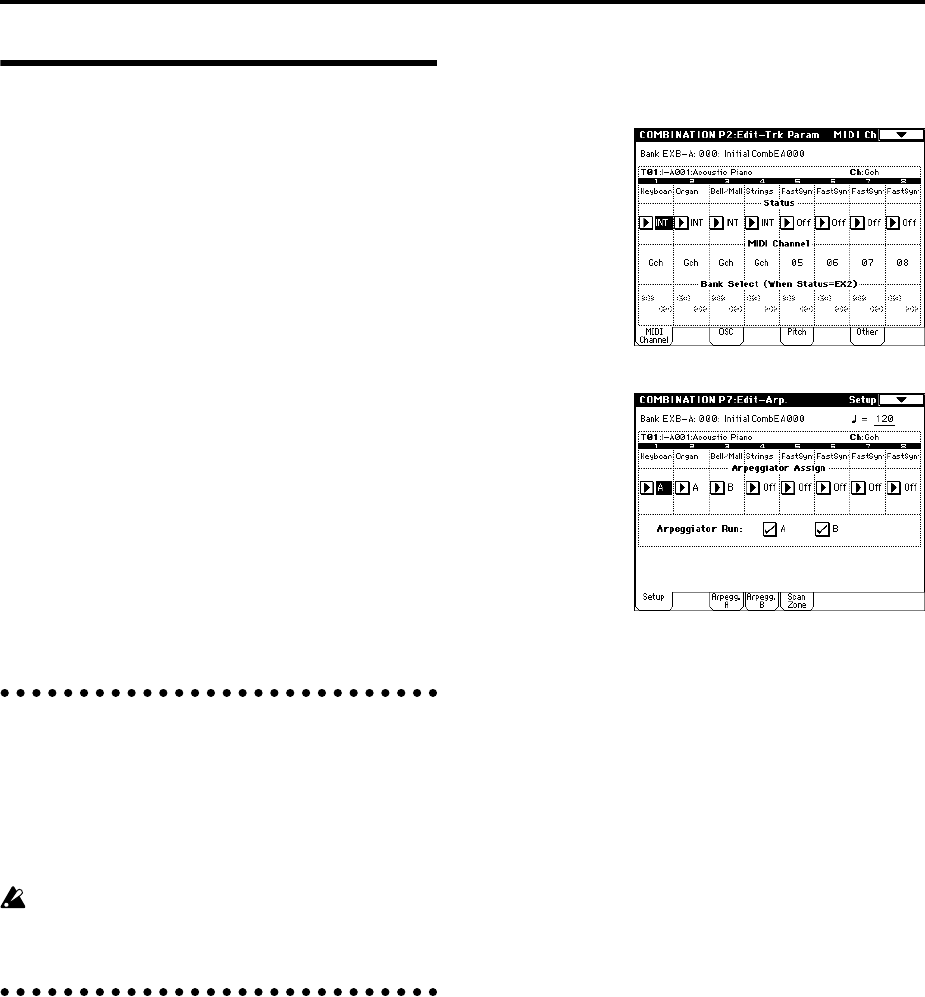
132
Arpeggiator settings in Combina-
tion and Sequencer modes
In Combination, Sequencer and Song Play modes, the
TRITON STUDIO provides dual arpeggiator functionality
that lets you use two arpeggio patterns simultaneously.
The settings in each of these modes are made in the simi-
lar way.
As an example, the following explanation shows how to
make settings in Combination mode. For a detailed expla-
nation and example settings (☞PG p.45, 81, 129).
The dual arpeggiator functionality lets you do the follow-
ing things.
• Assign an arpeggiator for each timbre. Choose from
Off, (arpeggiator) A, or (arpeggiator) B. ☞step5
• Independently specify whether A and B will operate.
☞step6
• Select an arpeggio pattern and set parameters
independently for A and B. ☞step7
• Make Scan Zone page settings so that you can use
keyboard range or playing velocity to switch between
normal playing and arpeggiated playing, or to switch
between arpeggiators A and B. ☞step8
• Make settings for timbres that will be silent when the
arpeggiator is Off, and will sound only when the
arpeggiator is On. ☞step0
Arpeggiator on/off
Each time you press the ARPEGGIATOR [ON/OFF] key,
the arpeggiator will be switched on or off. When on, the
ARPEGGIATOR [ON/OFF] key LED will light. The
selected arpeggio pattern will begin when you play the
keyboard. The on/off setting is saved when the combina-
tion is written into memory.
If “Assign” is Off or “Arpeggiator Run” is not
checked, the arpeggiator will not operate even if this
key is on.
Arpeggiator settings
1 Select Combination P1: Edit-Program/Mixer page.
Select programs for the timbres that you wish to use.
For this example, select any desired program for tim-
bres 1–4.
2 Select Combination P2: Edit-Trk Param, MIDI Ch
page.
For the timbres that you will be using, set “Status” to
INT, and set “MIDI Channel” to Gch or to the global
MIDI channel (set in Global P1: MIDI “MIDI Chan-
nel”).
For this example, set timbres 1–4 to a “Status” of INT,
and timbres 5–8 to a “Status” of Off. Set the “MIDI
Channel” of timbres 1–4 to Gch.
3 Select Combination P7: Edit-Arp., Setup page.
4 Set “ (Temp)” to specify the tempo.
This is the same as for a program (☞p.130). However,
the tempo is shared by both arpeggiators A and B.
5 Make “Arpeggiator Assign” settings.
Assign arpeggiator A or B to the desired timbres. Each
timbre will be played by the arpeggiator that has been
assigned to it.
6 Make “Arpeggiator Run” settings.
Check the arpeggiator(s) that you want to operate. The
arpeggiator(s) checked here will run when the ARPEG-
GIATOR [ON/OFF] key is turned on.
With the settings shown in the LCD screen for steps 2
and 3, turning the ARPEGGIATOR [ON/OFF] key on
will cause arpeggiator A to operate for timbres 1 and 2,
and arpeggiator B to operate for timbre 3. When the
ARPEGGIATOR [ON/OFF] key is turned off, timbres
1–4 will sound as a layer.
If all timbres “Assign” are Off, or if “Arpeggiator
Run” A or B is unchecked, the arpeggiator will not
function.
7 In the Arpeggiator A and Arpeggiator B pages, set the
parameters for arpeggiators A and B.
The parameters for A and B are the same as for a pro-
gram (☞p.130).
8 In the Scan Zone A/B page, specify the range in
which arpeggiators A and B will operate.
The parameters for A and B are the same as for a pro-
gram (☞p.130).
You can use keyboard ranges or playing velocity to
operate the arpeggiator, or to switch between arpeggia-
tors A and B. By using the Combination P4: Edit-Zone/
Ctrl, Key Zone page, and Vel Zone page to set key-
board ranges and velocity ranges in conjunction with
each other, you can create even more variations.
9 If you wish to save the edited combination settings in
internal memory, turn off memory protect in Global
mode, and write the combination. (☞p.57).


















